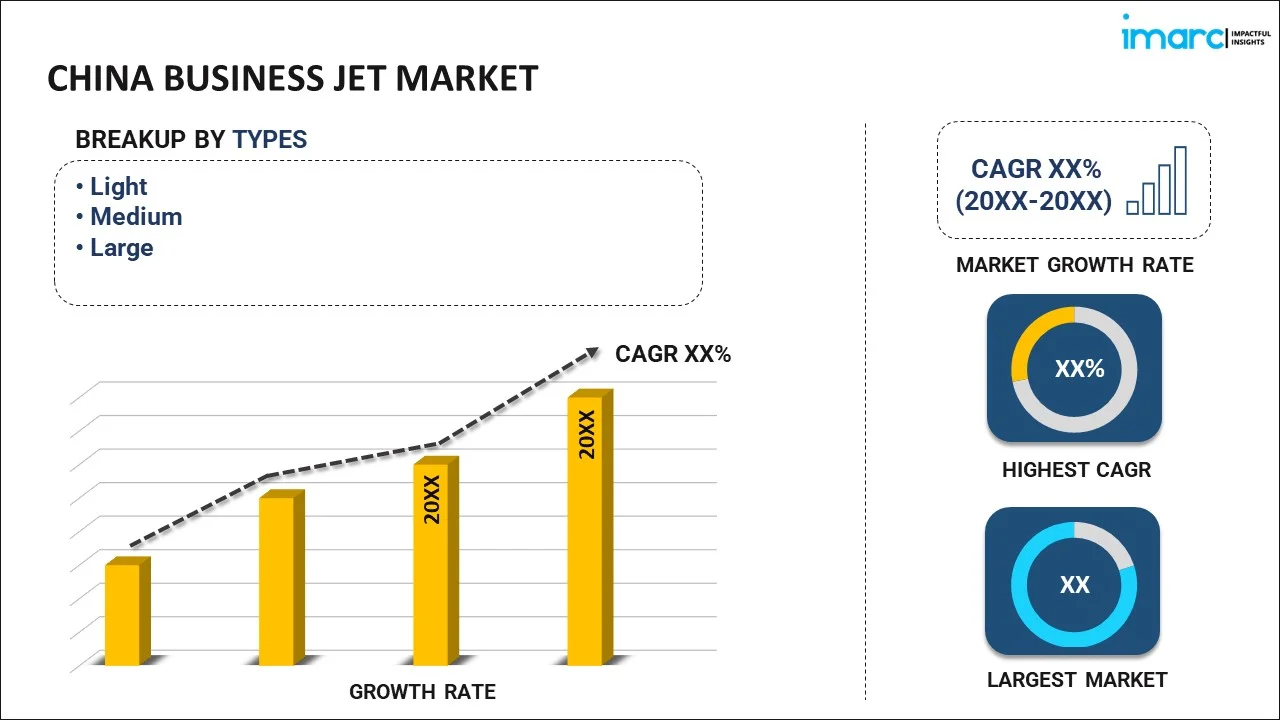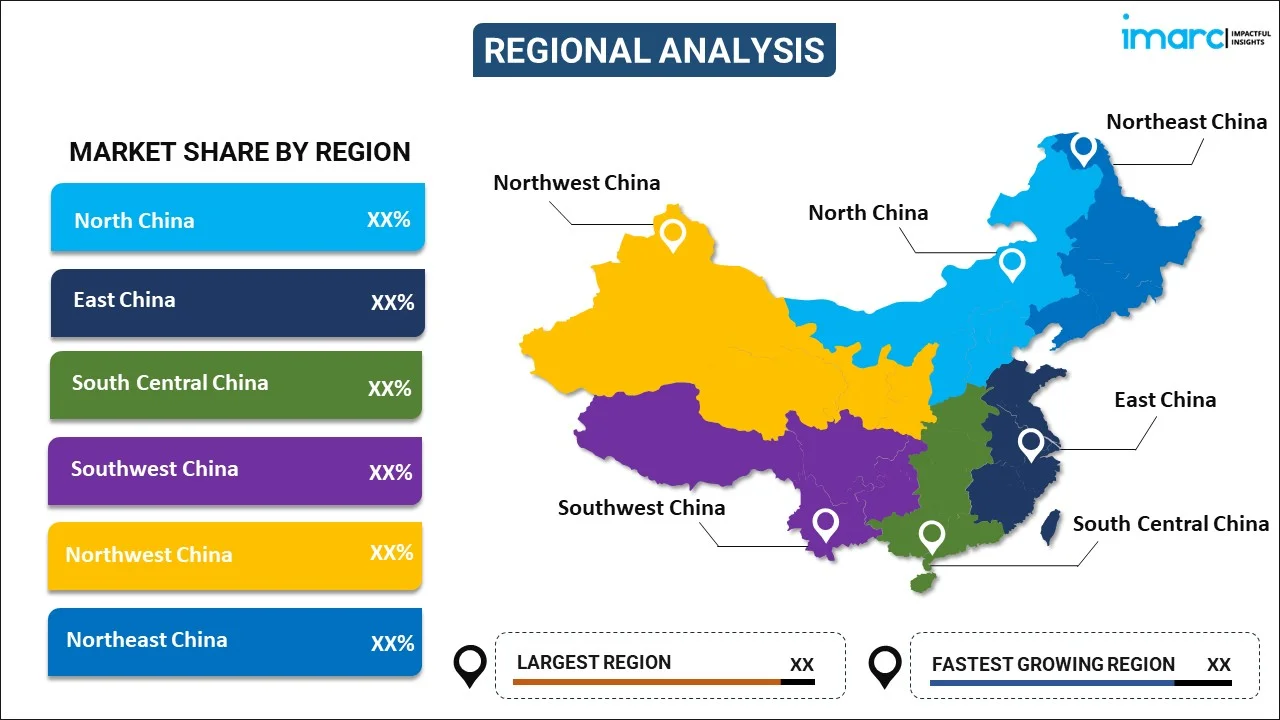
China Business Jet Market Report by Type (Light, Medium, Large), Business Model (On-Demand Service, Ownership), Range (< 3,000 NM, 3,000 - 5,000 NM, > 5000 NM), and Region 2024-2032
China Business Jet Market Overview:
The China business jet market is projected to exhibit a growth rate (CAGR) of 5.50% during 2024-2032. The growth in economy, increasing infrastructure development, rising globalization, development of general aviation, construction of new airports, and government support represent some of the key factors driving the growth of the market.
|
Report Attribute
|
Key Statistics
|
|---|---|
|
Base Year
|
2023 |
|
Forecast Years
|
2024-2032
|
|
Historical Years
|
2018-2023
|
| Market Growth Rate (2024-2032) | 5.50% |
China Business Jet Market Trends:
Economic growth
The growth in China’s economy and the increasing business environment are crucial in influencing the business jets market. China currently represents 10% of the global commercial aircraft market, providing a big opportunity for commercial aircraft manufacturers in the coming decade. Moreover, with increased infrastructure development and increased globalization of the China’s business, the need for efficient and convenient travel has emerged. Business aircraft allow top managers and businessmen to fly fast from one domestic or international location to another, increasing their performance and business results. According to the newly released full-year Fleet Report by Asian Sky Group (ASG), there were 1,154 business jets operating in Asia-Pacific at the end of 2023, marking a slight increase of 0.2% for the year after a 3.7% decline in 2022. East Asia led the region's growth with an 8.3% rise, driven by expanding fleets in countries like South Korea and Japan. Mainland China remained the largest business jet market in the region at the end of 2023, despite experiencing three consecutive years of net declines. The rate of decrease in China, which has a fleet of 272 aircraft, slowed to 3.2% in 2023, compared to a 14.3% drop in 2022. Corporations and high net worth individuals located in China are also increasingly using it to fund their investment projects, making the demand even higher. Furthermore, the development of the country’s aviation industry through construction of new airports and upgrade of existing airports aids the tremendous growth of business jet as it offers faster trip solutions of time-sensitive clients. According to the International Air Transport Association (IATA), China’s domestic passenger traffic has increased by an average of 10.5% annually over the past decade, making it one of the fastest-growing markets in the world.
Government Support
Government support and better regulations are considered the key factors to the expansion of the business jets market in China. For instance, In June 2022, the Civil Aviation Administration of China (CAAC) published the “14th Five-Year Plan for General Aviation Development” which set a goal to have 3,500 registered general aviation (GA) aircrafts and 500 GA airports in China by the end of 2025. China currently has about 3,200 registered GA aircrafts and 399 GA airports. The plan also calls for 25 or more provincial-level regions offer air rescue emergency services. China currently has 146 medical institutions in 23 provinces that offer emergency air rescue services. Furthermore, government backing of aviation developmental plans such as the FBOs as well as the maintenance centres supplement the business jet operational environment. These regulatory measures and infrastructural changes are very important for the promotion of business jets among local and foreign organizations which use these planes for their corporate travel.
China Business Jet Market News:
- In May 2024, Airbus SE announced plans to construct a new single-aisle jet factory in China, as Apple scales back. The European aerospace manufacturer will establish a second final assembly line at its current factory site in Tianjin, following an agreement signed by Chief Executive Officer Guillaume Faury in Beijing on Thursday."
- In May 2024, Gulfstream Aerospace Corp., a wholly owned subsidiary of General Dynamics announced the all-new Gulfstream G700 has received European Union Aviation Safety Agency (EASA) type certification, following the aircraft’s Federal Aviation Administration (FAA) type certification on March 29.
China Business Jet Market Segmentation:
IMARC Group provides an analysis of the key trends in each segment of the market, along with forecasts at the country level for 2024-2032. Our report has categorized the market based on type, business model, and range.
Type Insights:

- Light
- Medium
- Large
The report has provided a detailed breakup and analysis of the market based on the type. This includes light, medium, and large.
Business Model Insights:
- On-Demand Service
- Air Taxis
- Branded Charters
- Jet-Card Programs
- Ownership
- Fractional Ownership
- Full Ownership
A detailed breakup and analysis of the market based on the business model have also been provided in the report. This includes on-demand service (air taxis, branded charters, and jet-card programs) and ownership (fractional ownership and full ownership).
Range Insights:
- < 3,000 NM
- 3,000 - 5,000 NM
- > 5000 NM
The report has provided a detailed breakup and analysis of the market based on the range. This includes < 3,000 NM, 3,000 - 5,000 NM, and > 5000 NM.
Regional Insights:

- North China
- East China
- South Central China
- Southwest China
- Northwest China
- Northeast China
The report has also provided a comprehensive analysis of all the major regional markets, which include North China, East China, South Central China, Southwest China, Northwest China, and Northeast China.
Competitive Landscape:
The market research report has also provided a comprehensive analysis of the competitive landscape in the market. Competitive analysis such as market structure, key player positioning, top winning strategies, competitive dashboard, and company evaluation quadrant has been covered in the report. Also, detailed profiles of all major companies have been provided.
China Business Jet Market Report Coverage:
| Report Features | Details |
|---|---|
| Base Year of the Analysis | 2023 |
| Historical Period | 2018-2023 |
| Forecast Period | 2024-2032 |
| Units | US$ Million |
| Scope of the Report | Exploration of Historical Trends and Market Outlook, Industry Catalysts and Challenges, Segment-Wise Historical and Future Market Assessment:
|
| Types Covered | Light, Medium, Large |
| Business Models Covered |
|
| Ranges Covered | < 3,000 NM, 3,000 - 5,000 NM, > 5000 NM |
| Regions Covered | North China, East China, South Central China, Southwest China, Northwest China, Northeast China |
| Customization Scope | 10% Free Customization |
| Post-Sale Analyst Support | 10-12 Weeks |
| Delivery Format | PDF and Excel through Email (We can also provide the editable version of the report in PPT/Word format on special request) |
Key Questions Answered in This Report:
- How has the China business jet market performed so far and how will it perform in the coming years?
- What has been the impact of COVID-19 on the China business jet market?
- What is the breakup of the China business jet market on the basis of type?
- What is the breakup of the China business jet market on the basis of business model?
- What is the breakup of the China business jet market on the basis of range?
- What are the various Types in the value chain of the China business jet market?
- What are the key driving factors and challenges in the China business jet?
- What is the structure of the China business jet market and who are the key players?
- What is the degree of competition in the China business jet market?
Key Benefits for Stakeholders:
- IMARC’s industry report offers a comprehensive quantitative analysis of various market segments, historical and current market trends, market forecasts, and dynamics of the China business jet market from 2018-2032.
- The research report provides the latest information on the market drivers, challenges, and opportunities in the China business jet market.
- Porter's five forces analysis assist stakeholders in assessing the impact of new entrants, competitive rivalry, supplier power, buyer power, and the threat of substitution. It helps stakeholders to analyze the level of competition within the China business jet industry and its attractiveness.
- Competitive landscape allows stakeholders to understand their competitive environment and provides an insight into the current positions of key players in the market.
Need more help?
- Speak to our experienced analysts for insights on the current market scenarios.
- Include additional segments and countries to customize the report as per your requirement.
- Gain an unparalleled competitive advantage in your domain by understanding how to utilize the report and positively impacting your operations and revenue.
- For further assistance, please connect with our analysts.
 Inquire Before Buying
Inquire Before Buying
 Speak to an Analyst
Speak to an Analyst
 Request Brochure
Request Brochure
 Request Customization
Request Customization




.webp)




.webp)












